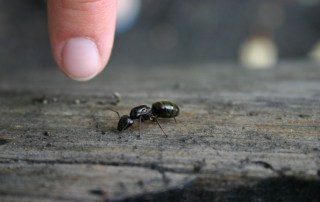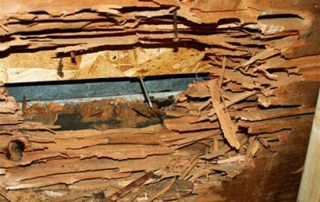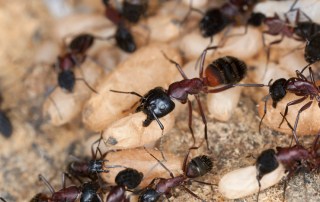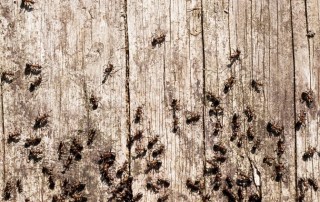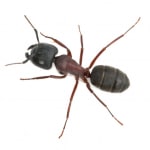The black gossamer ant is a colony-dwelling insect.Most are black, but one variety is black and red.There are several hundred to several thousand individuals in a single population belonging to one of 3 castes: male breeders and queens, workers, and soldiers.Colonies can contain from 2,000 to 6,000 individuals.
Latin name: Camponotus Pensylvanicus
Description:The black gossamer ant is a colony-dwelling insect.Most are black, but one variety is black and red.There are several hundred to several thousand individuals in a single population belonging to one of 3 castes: reproductivemales and queens), workers, and soldiers.Colonies can contain from 2,000 to 6,000 individualsThe males are winged and die after impregnating the queen. Their color varies from red to black.They measure 9 to 10 mm.All males have two pairs of wings.The front wings are much longer than the back wings.Queens lose their wings after mating.Their color varies from red to black.The queen of a carpenter ant colony has an ultra-developed abdomen.They are the largest individuals in the colony and measure up to 18 mm.The workers are sterile and wingless females. They vary in color and range in size from 6 to 10mm.They have well-developed crushing mouthparts.Soldiers are sterile, wingless females.They are slightly larger in size than the workers.Their heads and mouthparts are larger.The presence of large soldiers indicates a more mature colony that has been living in the same location for a long time.
Mating:Mating of carpenter ants usually takes place in May.Each young queen mates with a single male and copulation takes place in flight.The abdomen of the queen contains a spermatheca. The abdomen of the queen contains a spermatheca. This small spherical receptacle receives the spermatozoa of the male during mating. The spermatheca produces nutrients that keep the seed alive for several years, allowing the queen to lay thousands of eggs without further contact with a male. After mating and nuptial flight, the fertilized queen drops her wings by rubbing them with her legs. She then looks for a suitable place to set up her colony, such as a tree trunk, a large stump or a piece of wood. Once in her new home, the queen lays her first eggs and takes care of this first clutch on her own, feeding it from her own reserves. The first adult workers are very small. This first generation of workers, and all subsequent generations, take over the work of the anthill: maintenance, enlargement of the shelter, provisioning of the occupants, etc. The queen is the only female who lays eggs in a colony and she devotes her life to this occupation. When a new queen founds a colony, she feeds the first larvae with food eggs, which contain only nutrients. The queen herself may have to feed on her own eggs to survive until the first workers take over. Later, if the colony is under severe stress, the queen may resort to cannibalism to ensure her survival. A colony is well established after three to six years, when it has 2,000 or more workers. From this point on, the queen produces winged and sexed individuals (males and future queens) at the end of each summer. These new reproductive adultsaccumulate reserves and overwinter in the ant hill.
Habits:Carpenter ants are omnivorous insects. In the wild, they feed on honeydew produced by aphids and other homopterans, dead or living insects and small invertebrates, and the juices of various plants and fruits.The food is often consumed on the spot by the ants in charge of the food supply, and then regurgitated to the queen, larvae, and other workers when they return to the nest. Less frequently, the food may also be brought back intact and stored in the nest. The workers move up to a hundred meters from the nest in their search for food.When they enter our homes, the ants add to their menu a host of sweet foods, meats, pet food and fats.They can eat almost anything that humans eat.They grow mushrooms in rotten wood that they have located in a damp spot in the house frame, caused by water damage, for example.
They are also known as « fungus ».
Prevention:All homes, are vulnerable to infestation and damage caused by these ants.Inside residences it is necessary to keep the premises clean and in good condition.Any water leakage from the roof or pipes must be repaired quickly.Avoid storing firewood indoors. If there is an infestation, it is important to locate the nest(s) by observing the behavior of the ants.Finally, treatments can be applied but should be administered by specialists to ensure that all sources of infestation are treated.
We can also treat ants in the same way as we do for other insects.
We also treat all other pest problems ( wasps, carpenter ants, cockroaches, bed bugs, grubs etc)
To learn more about these pests, visit our encyclopedia of parasites.

